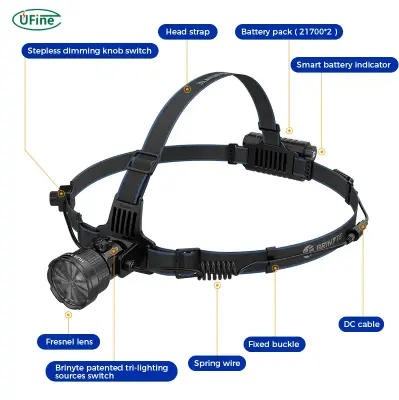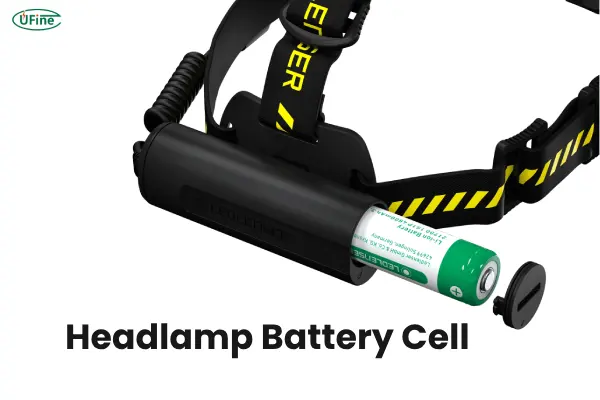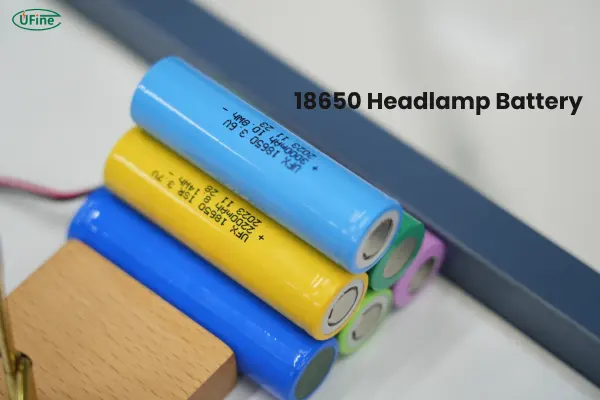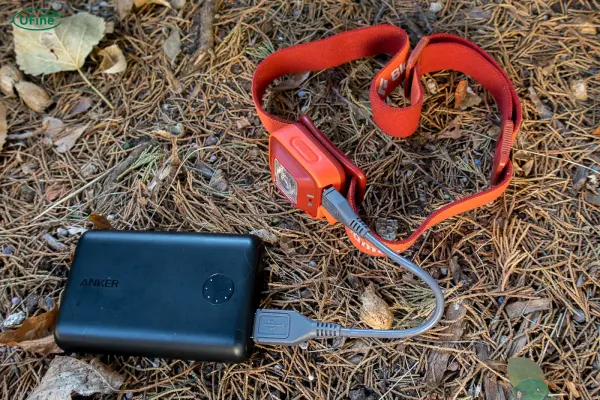
- Part 1. Headlamp battery size: Why size matters
- Part 2. How many cells does a headlamp battery have?
- Part 3. Headlamp battery chemical types
- Part 4. Rechargeable vs non-rechargeable: Which is better?
- Part 5. How long can a headlamp battery last?
- Part 6. Dealing with headlamp battery corrosion
- Part 7. How to choose a headlamp battery charger?
- Part 8. In conclusion
- Part 9. FAQs
A good headlamp can be your best friend during a night hike, power outage, or even a late-night garage repair. But none of that matters if it doesn’t have the right battery. And when it fails on you in the middle of the dark—let’s be honest—it’s frustrating, even scary. This is why understanding the headlamp battery—its type, size, capacity, chemistry, and performance—is not just a tech topic, but a matter of confidence and safety.
Let’s dig deeper into what powers your headlamp and how to make smart choices that last.
Part 1. Headlamp battery size: Why size matters
Headlamps use different battery sizes depending on their design and brightness. The most common sizes are:
- AAA (1.5V): Found in lightweight, low-power headlamps.
- AA (1.5V): Offers longer life, used in mid-range models.
- CR123A (3V lithium): Used for high-lumen tactical headlamps.
- 18650 Li-ion (3.7V): Rechargeable, long-lasting, common in advanced or professional headlamps.
- Custom lithium batteries: Tailored sizes and capacities for niche or high-performance uses.
Battery size affects not only run time but also weight, brightness, and charging compatibility.
Tip: Always check your headlamp’s manual before replacing batteries. Using the wrong size could damage the device or reduce performance.
Part 2. How many cells does a headlamp battery have?
The number of battery cells can significantly influence a headlamp’s output and runtime. Here’s a quick breakdown:
- Single-cell systems (like one 18650 or 3xAAA): Lightweight, ideal for casual use.
- Multi-cell systems (two or more 18650s or battery packs): Higher voltage and longer duration, great for mountaineering, cave exploration, or rescue missions.
Some advanced headlamps even allow external battery packs, which distribute weight better and extend runtime. This is where custom battery solutions become a game-changer.
Need a specialized battery pack?
Ufine Battery manufactures custom lithium battery packs for headlamps and other portable devices. Whether you need more runtime, higher voltage, or ultra-lightweight builds, Ufine can help you design it.
Contact Ufine Battery today to design your perfect headlamp battery solution.
Part 3. Headlamp battery chemical types
Not all batteries are created equal. The chemical composition of your headlamp battery impacts power density, temperature tolerance, rechargeability, and weight.
Here are the main types:
Alkaline (AAA/AA)
- Cheap and widely available.
- Non-rechargeable.
- Can leak and corrode over time.
- Poor performance in cold weather.
NiMH (Nickel Metal Hydride)
- Rechargeable alternative to alkaline.
- Lower voltage (1.2V) but better for the environment.
- Shorter life cycle compared to lithium.
- Loses charge over time (self-discharge).
Lithium (Li-ion, Li-polymer, LiFePO4)
- High energy density and excellent performance.
- Rechargeable with fast charge options.
- Lighter than NiMH and alkaline.
- Great in cold or hot temperatures.
- Available in cylindrical (18650, 21700) and pouch (polymer) forms.
Among these, Li-ion and LiFePO4 batteries dominate high-performance headlamps today. Their long life and consistent output make them ideal for adventure seekers and professionals alike.
Ufine Battery offers a wide range of lithium battery chemistries, including LiFePO4, Lithium Polymer, and high-temperature lithium cells, designed for demanding conditions and tailored specs. Contact us to customize your perfect battery.
Part 4. Rechargeable vs non-rechargeable: Which is better?
Here’s the big debate. Should you go rechargeable or stick to good old disposables?
Rechargeable Headlamp Batteries
- Eco-friendly: Reduce waste.
- Cost-effective over time.
- Great for frequent use.
- Usually lithium-based (18650, LiPo).
- Some built-in USB-C or magnetic charging options.
Non-Rechargeable Batteries
- Convenient: No need to charge.
- Longer shelf-life, good for emergency kits.
- Readily available (AA, AAA, CR123A).
- Not suitable for high-drain applications.
If you use your headlamp regularly—for work, hiking, or camping—rechargeable is the clear winner. But if you need it only occasionally or in emergencies, a spare pack of AAAs can be a lifesaver.
Want a rechargeable battery that’s built exactly for your headlamp’s needs?
Ufine Battery specializes in custom rechargeable lithium battery solutions, including compact, lightweight, and high-drain cells.
Part 5. How long can a headlamp battery last?
Battery life depends on:
- Battery type and capacity
- Brightness mode (high vs low vs strobe)
- Headlamp efficiency
- Temperature and usage environment
For example:
| Battery Type | Run Time (High Mode) | Run Time (Low Mode) |
|---|---|---|
| 3xAAA Alkaline | 2–4 hours | 20+ hours |
| 18650 Li-ion (3200mAh) | 3–10 hours | 40+ hours |
| CR123A Lithium | 3–6 hours | 30+ hours |
Temperature extremes can significantly reduce runtime—another reason to consider Ufine’s high-temperature lithium batteries, designed for reliability in harsh environments.
Part 6. Dealing with headlamp battery corrosion
Battery corrosion is not just gross—it can destroy your headlamp.
What Causes It?
- Leaking alkaline batteries.
- Long-term storage without use.
- Humid or hot environments.
What to Do If You See Corrosion
- Remove the batteries immediately.
- Use gloves and eye protection.
- Clean the contacts with a mix of baking soda and water or white vinegar.
- Dry completely before inserting new batteries.
How to Prevent It
- Remove batteries if storing for long periods.
- Use leak-proof lithium batteries instead of alkalines.
- Store in a cool, dry place.
- Clean terminals every few months.
Pro tip: Opt for rechargeable lithium batteries. They’re sealed, leak-resistant, and safer.
Part 7. How to choose a headlamp battery charger?
If your headlamp uses rechargeable batteries, don’t overlook the charger—it plays a big role in battery health and safety.
What to Look For:
- Compatibility with your battery type (18650, LiFePO4, LiPo).
- Smart charging with overcharge protection.
- Multiple slots if you use several batteries.
- USB or Type-C support for travel convenience.
- Cooling features for safety during fast charging.
A poor-quality charger can shorten your battery’s life or even cause it to fail. Always use a reliable, recommended charger.
Need help finding the right one? Ufine Battery provides matching battery packs and chargers for optimal performance. Reach out and we’ll recommend a combo that works for you.
Part 8. In conclusion
The right headlamp battery can mean the difference between clarity and chaos in the dark. From understanding sizes and chemistries to choosing the right charger and care tips, it all adds up to performance, reliability, and peace of mind.
Whether you need custom battery packs, high-rate lithium cells, or ultra-thin rechargeable batteries, Ufine Battery has you covered. With years of expertise and cutting-edge manufacturing in China, we help you power up confidently—no matter the application.
Part 9. FAQs
Can I use a different battery than the one recommended in my headlamp?
No, using an incompatible battery can damage your headlamp or reduce output. Always follow the manual or consult the manufacturer.
Is it safe to use 18650 batteries in cold weather?
Yes, but performance may drop below freezing. Ufine’s high-temperature lithium batteries are built for extreme conditions.
How often should I replace rechargeable batteries?
Typically after 300–500 charge cycles. Signs of aging include shorter runtime and inconsistent brightness.
Can I charge a Li-ion battery with a NiMH charger?
Absolutely not. Different chemistries require different charging voltages and protection circuits.
How can I tell when my headlamp battery is low?
Some headlamps have indicators or blinking modes. If brightness drops suddenly, it’s time to recharge or replace.
Related Tags:
More Articles
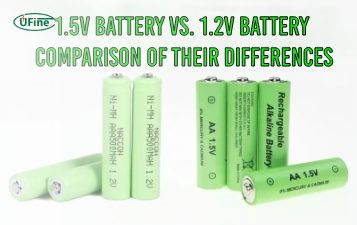
1.5V Battery Vs. 1.2V Battery: Comparison of Their Differences
Compare 1.2V vs 1.5V batteries: voltage, usage, rechargeability. Best for remotes, toys, cameras. Discover which AA battery suits your device.
Recommended 10 Best Batteries For Smoke Detectors
Discover the best batteries for smoke detectors in 2025. Compare top 10 9V and AA options for long-lasting, leak-proof, and reliable smoke alarm power.
Triple A Battery Voltage: Everything You Need to Know
Learn how many volts are in a triple A battery (1.5V vs 1.2V), see AAA battery voltage chart, and compare chemistry, testing, and lifespan for 2025 devices.
9V vs AA Batteries for Fire Alarm: Which One Should You Use?
Compare 9V and AA batteries for smoke detectors. Learn which type provides better lifespan, voltage, and cost efficiency to keep your fire alarms reliable.
Flashlight Battery Size: Types, Choosing Tips and FAQs
Explore flashlight battery sizes with an easy chart. Learn what batteries small flashlights use and how to pick 18650, 26650, 14500, or CR123A cells.
